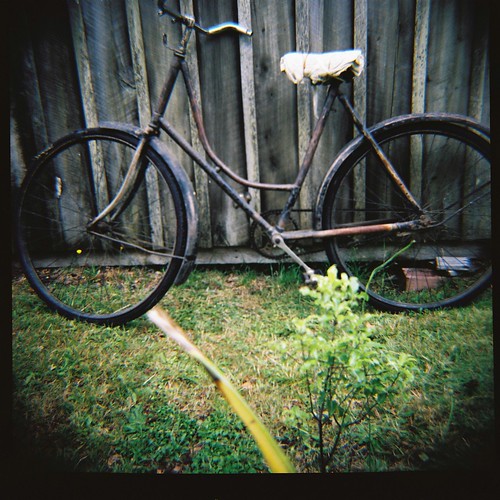As I already mentioned
last week, I'm currently attending a
Mobility Week Workshop in Budapest, Hungary. It's a meeting of 30 young Europeans from basically 6 different countries (Austria, Czech Republic, Finland, Italy, Hungary, Spain). After exploring the city center and area around the youth hostel
Casa de la Musica, we will set different goals and work on how this area could be improved mobility-wise.
 My bike impatiently waits for our departure at Wien Südbahnhof
My bike impatiently waits for our departure at Wien Südbahnhof I. (another girl from Vienna) and myself brought our own bikes along. Unfortunately, this is unnecessarily complicated since bike transport is only possible on the slow regional
trains. Apart from the longer traveling time (4 rather than 3 hours) this also includes also other disadvantages for cyclists. For example, we had to change trains twice and always drag all our luggage and the bikes up and down the stairs at the stations (no elevators, not even rails on the stairs for wheelchairs – how do disabled people manage that?). Apart from that we didn't arrive at the main station Keleti in Pest but further outside at the Deli station in Buda.
 I. at Györ station: changing trains means draging bikes and luggage up and down the stairs
I. at Györ station: changing trains means draging bikes and luggage up and down the stairsSuch things really annoy me. I don't understand why they discourage people to bring along bikes on long distance journeys. I think the EU should really try to work towards a excellent train network that includes possibilities for bike transport. Nowadays it's almost impossible to bring bikes (except folding bikes) on long-distant trains and the situation actually gets worse and worse, at least in and around Austria after the Austrian railway network ÖBB introduced their new Railjet trains that simply don't transport bikes. Such things just make me sad.
So, after all, how is
cycling in Budapest? Before we left, we heard all kinds of stories basically saying that cycling in Budapest is very dangerous and that car drivers are aggressive. I must say that I didn't have that impression at all. Of course, there is a lot of
car traffic. The roads and lanes are wide and the motorists get priority over everybody else. But cycling in traffic is not so bad. Car drivers leave a lot of space to the side when overtaking and nobody ever honked at us. With all our luggage (both of us had a 50l backpack and a small one) we found our way to the hostel easily and safely. We only had a problem once after we got on a bike path as this one actually lead us away from the Erzsébet bridge rather than onto it. So we ended up carrying our bikes up and down stairs (again) and crossed the Danube on the sidewalk of the bridge. Well, the view was great and we took some nice pictures :-). Though our first cycling trip in Budapest was actually quite pleasant.
 Night view from Erzsébet bridge to Buda, Danube and Pest
Night view from Erzsébet bridge to Buda, Danube and PestThe next day we cycled through Budapest on
rented bikes from
Budapestbike in the whole group of 30 people. That way we could see some of the
bicycle infrastructure in the city. There is not much and of course there are many improvements that could be made. Compared to Vienna, however, I quite enjoyed that the bike lanes on the road are so wide here and even have an empty space between the parked cars (absolutely necessary and should be standard anyhow, but Viennese planners apparently don't believe in "dooring"). I didn't like the segregated two-way bike paths so much as they are quite narrow and not so visible from the car lanes (always problems with cars turning right that only see cyclists at the last moment). Still, I liked their clear and straight design and that they had a center line. At some places the surface was quite rough though. Very often the bike lanes are painted red at junctions, but the color already faded away.
Cycling in Budapest: cycling in traffic, on a bike lane and a two-way bike path
What I really miss here are
one way streets with contraflow cycling traffic. That is something that works very well in Vienna and that really safes me a lot of time in everyday life. They do try to implement such things here too. As mentioned in one of the talks, they also have one
advanced stop lane for cyclists (meaning that cyclists can stop in front of the first row of cars at traffic lights, also referred to as 'bike box') and so-called
suggested cycle lanes (simply bike pictograms on the road with no real bike infrastructure – I reckon that they are much more efficient than small signs beside the road saying that this is a bike route, as these are not really seen by car drivers).
Concerning bike infrastructure (and generally traffic and spatial planning), Budapest still has a long way to go, but cycling is possible and safe if one is cautious. Cycling, however, is certainly not pleasant here. Still, cyclists in Budapest already represent 3-5% of the modal split which is quite similar to Vienna (as far as I know we have 5% cyclists, but already 8% in the “summer months”), and the numbers are continuously increasing.
More about other aspects of traffic in Budapest and a flashmob by “radical pedestrians” at the Blaha Lujza square in the next post. Stay tuned.
Information of the whole idea and activities in the Mobility Week Workshop on the
official website:
mobilityweekbudapest.eu. Have a look at the
project diary.











































